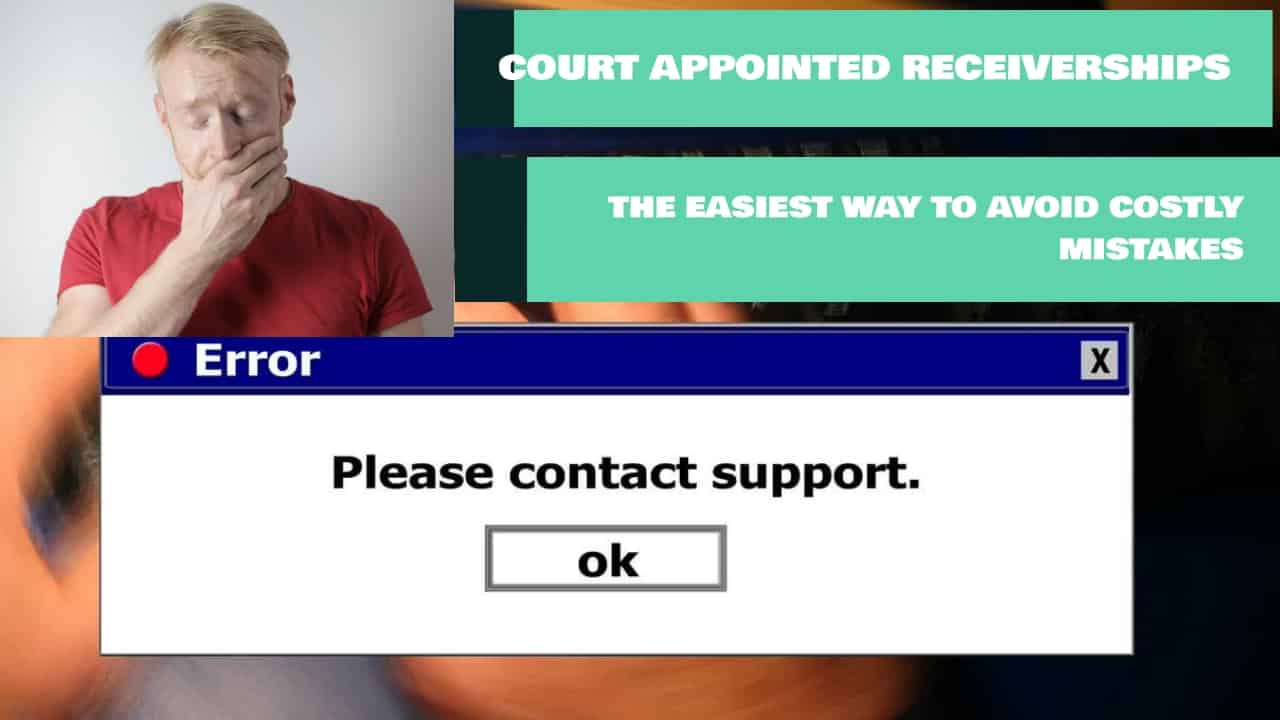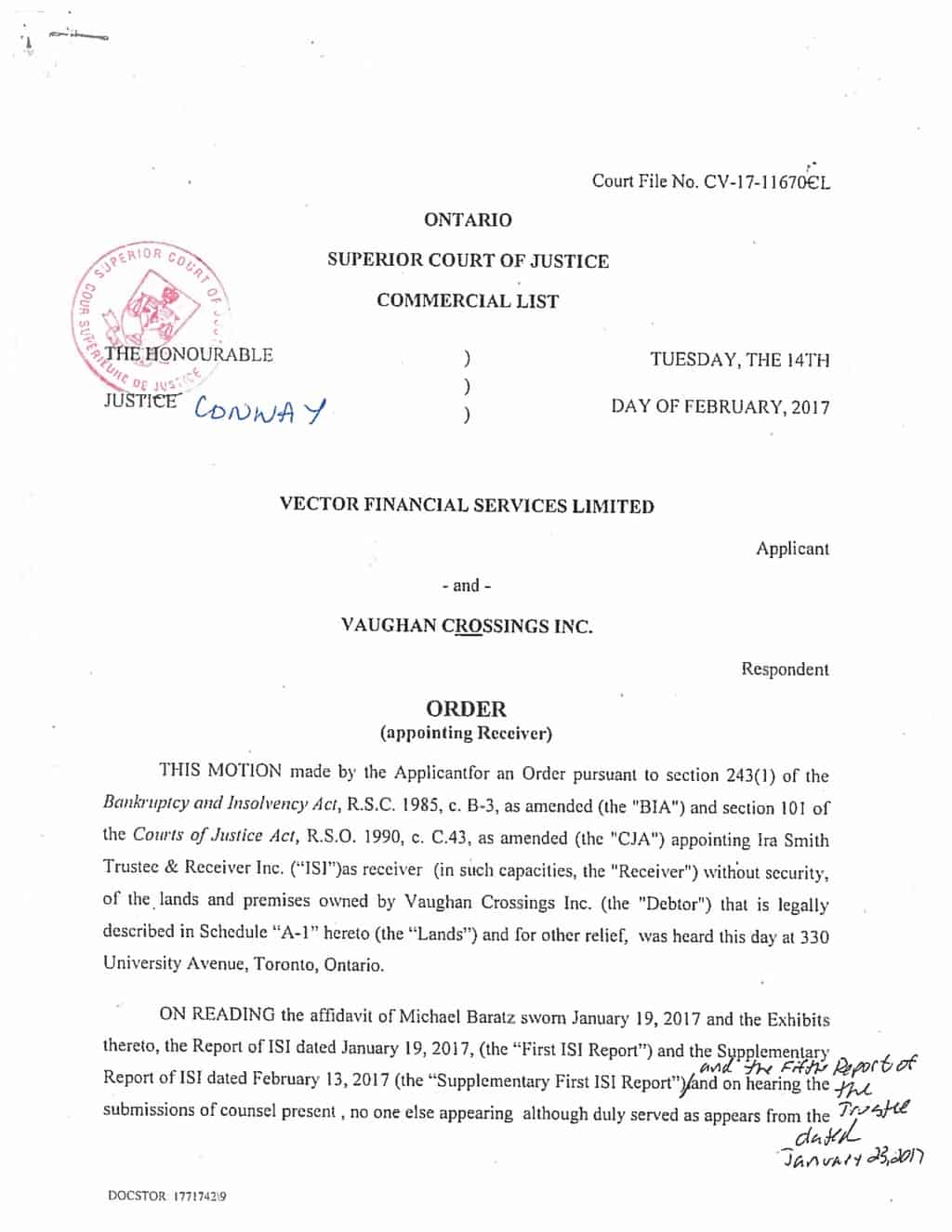what is a receivership?
We hope that you and your family are safe, healthy and secure during this coronavirus pandemic. Ira Smith Trustee & Receiver Inc. is absolutely operational and Ira, in addition to Brandon Smith, is readily available for a telephone consultation or video meeting.
What is a receivership?
What is a receivership is a question I am asked often. Receivership is a remedy available to secured lenders to recoup as much of their debt as possible. A secured creditor, normally a financial institution, has lent funds to the company or individual under a secured financing transaction. They did it this way so in the event the company or person defaults on its finance payments, they can enforce against the assets subject to the security.
Receivership is a different process than bankruptcy for the sale of the properties of a corporation. In Canada, the secured creditor is typically the Bank as the lender. Normally, when a borrower misses payments, they tend to be insolvent. However, it is possible to have a receivership in Ontario even if the borrower is not insolvent.
In this Brandon Blog, I am going to tell you all about receivership. What is a receivership? How it works. When it can be used? What types of receivership are there?
What is a receivership? Examples of receivership in a sentence
What is a receivership? Receivership is a legal proceeding. Either a secured creditor privately appoints the receiver by instrument or a court appoints a person or company, called a receiver, to collect and manage the assets of a person or business that is unable to manage those assets effectively.
To understand more about the receivership process, we first need to look at the types of receivership. These are:
- Liquidating receivership – This is a type of receivership that is brought about when a company ceases operations because the management of the company is unable to make it a viable business again. If the business is not viable, then the receiver will not operate it and will find buyers for the assets.
- Operating receivership – This form of receivership is when parts of the company are viable or must otherwise continue operating under receivership. The business assets have a great deal of value if operating, but if shut down, relatively no value. In this case, the receiver will continue operating the business and the secured creditor will agree to lend funds if the business’s cash flow is insufficient. While operating the business, the receiver will also look for buyers.
The word “receiver” originally meant “a person appointed by a court to manage the affairs of another, especially a bankrupt or insolvent“. The term is now more widely applied and refers to a person placed in temporary charge and control of another person’s assets or a business entity. A receivership is a form of governance used in a wide range of situations. It is particularly common in the fields of law and business.
What is a receivership in a sentence – A receivership is a legal process started by a secured creditor either privately appointing a receiver by instrument or making an application to the court for an order that forces a party to carry out the duties of a receiver over the assets of a company or person.

In Canada, section 243(4) of the Bankruptcy and Insolvency Act (Canada) (BIA) dictates that only a licensed insolvency trustee can act as a receiver. From the above, you should now realize that there are two types of receivers: (i) privately appointed receiver; and (ii) court-appointed receiver.
What is a receivership? 10 – Day Notice of Intention to Enforce Security
Section 244 of the BIA relates to a secured creditor who intends to enforce its security against an insolvent debtor, either through private appointment or by making an application to the court. This section states that any secured creditor who intends to enforce against all, or substantially all, of the inventory, accounts receivable or other property used by the insolvent debtor in its business, must give adequate notice. The notice must be in writing by using the form prescribed by the BIA.
The BIA defines adequate as a minimum of 10 days. A secured creditor must send out the 10-day notice of intention to enforce security and cannot enforce its security until the 10 days have expired unless the debtor consents in writing to earlier enforcement. The purpose of giving the 10-day notice is to allow the insolvent debtor a chance to either negotiate some resolution with the secured creditor or otherwise attempt to reorganize its financial affairs. An example of reorganizing would be speaking with new potential lenders, consideration of assets that could be sold to repay or otherwise reduce the indebtedness to the unhappy secured creditor.
The insolvent debtor may also be considering invoking an insolvency process such as a Division I Proposal under the BIA to reorganize all of its debts to implement a financial reorganization strategy. If a proposal or a notice of intention to make a proposal under the BIA is filed by the insolvent debtor before the expiry of the 10 day period, then the enforcement action of the secured creditor has initially stayed.
That secured creditor would have to make an application to the court to show that it has lost total confidence in the insolvent debtor’s abilities and it will not support any reorganization attempt. The application is to lift the automatic stay of proceedings that happened when the insolvent debtor filed, to allow the secured creditor to enforce its security against the assets to try to recover as much of the secured debt as possible through the appointment of a receiver.
Why did 10 days become the official notice period? This was part of amendments to the BIA made in 2009. It arose as a .esult of court decisions over what is reasonable notice. The most famous case is one that insolvency practitioners refer to as Lister v. Dunlop. The case made its way all the way up to the Supreme Court of Canada. The proper name of the case is R.E. Lister Ltd. v. Dunlop Canada Ltd., [1982] 1 S.C.R. 726. The decision was released on May 31, 1982.
The case dealt with a variety of issues, including what is receivership. Another of the issues considered was a reasonable notice to be given when a secured creditor demanded repayment of its demand loan, due to one or more defaults on loan? The most common default is defaulting on making the required loan payments on time. The loan agreement and debenture securing the loan stated that it was a demand loan and that the lender must give reasonable notice when making the demand.
However, in the “old days”, there was never a definition of what reasonable notice was. In fact, in Ontario, the law at the time was that reasonable notice only came into being if the business owner asked for a time to repay the loan. What was reasonable was a matter of discussion and negotiation. In Lister v. Dunlop, it was determined that Dunlop did not provide reasonable notice, based on the specific facts in that case.
Case law evolved and eventually, in 2009, the BIA was amended as part of the new provisions to bring receivership under the BIA and receivers subject to the supervision of the Office of the Superintendent of Bankruptcy Canada. The 10 day notice period was Parliament’s way to try to codify what reasonable notice is.
Court Appointed Receivers vs. Privately Appointed Receivers
As discussed above, receivers are appointed when secured creditors want to recover on their secured loans. Receivership is a remedy for secured creditors. It is not a remedy for unsecured creditors. The intent is for the receiver to take possession of the insolvent company assets subject to the security agreement and conduct a sale of assets. The proceeds of the sale will then be distributed in accordance with the priority of the creditors under the BIA. The secured creditor should want to make sure that it is in the first place to receive the funds from the receiver, for the receivership process they are paying for!
From the above, by now, you have probably realized that a privately appointed receiver is appointed in writing by the secured creditor. The receiver gets properly retained and then is given an appointment letter by the secured creditor after the 10 day notice period has either passed or was waived by the insolvent debtor. The privately appointed receiver gets its powers from the security documents which will outline the approved steps the receiver can take.
Court-appointed receivers, as the term implies, are appointed by the court. The secured creditor properly retains the receiver and makes an application to the court for the appointment of the receiver. The secured creditor is the plaintiff in this litigation. If the court grants the order, then the court-appointed receiver begins the receivership administration. The powers and responsibilities of the court-appointed receiver come from the court order, called the Appointment Order.
The steps the receiver will take in determining what method will realize the most money possible from the sale of assets should be pretty well identical under both a court-appointed receivership and a privately appointed receivership. The analysis of how and the steps to be taken to realize the most money possible from the assets of the company in receivership should be the same, regardless of the form of appointment.
Either way, as stated above, the receiver must be a licensed insolvency trustee who is experienced in acting as a licensed insolvency practitioner.

What is a receivership? Duties of a receiver
Receivers are required to act honestly and in good faith. A privately appointed receiver has a duty to the secured creditor who appointed the receiver. A court-appointed receiver has a duty to act in good faith to all creditors.
The main roles of the receiver, whether private or court-appointed, can be summarized as to:
- Secure all the assets of the insolvent debtor pledged under the security agreement or covered by the Appointment Order.
- Make sure the receiver has control of property, the assets are conserved and properly insured.
- Advance the rights of the debtor with the approval of either the secured creditor or the court. This could include continuing or beginning any necessary litigation.
- Formulate the plan to maximize the realization from the sale of assets. This also involves a decision as to whether or not to operate the business of the company.
- Offer the assets for sale in a properly advertised public sale.
- Complete the sale and distribute the net proceeds in accordance with the provisions of the BIA.
- Make regular reporting to the court and/or the appointing creditor
- Obtain the approval of the secured creditor, and under a court appointment, approval of the court for all actions to be taken by the receiver.
- In a court appointment, to obtain the approval of the court for its fee and disbursements and for those of the receiver’s legal counsel.
The Appointment Order generally will give the court-appointed receiver extensive powers.
I want to summarize the difference between company receivership and bankruptcy
I find that many times people will confuse the terms receivership and bankruptcy. What is a receivership is not the same as what is bankruptcy. I want to summarize the difference between company receivership and bankruptcy. There are important differences between bankruptcy and receivership.
The terms bankruptcy and receivership are often mistakenly used; they are not the very same thing. Bankruptcy is a legal process for unsecured creditors. The bankruptcy of a person and that person’s discharge from bankruptcy acts to discharge that person’s unsecured debt. As a company is never discharged from bankruptcy, the bankruptcy process has the effect of ending the company’s business.
What is a receivership? Receivership on the other hand, is a legal process for the benefit of secured creditors that safeguards their security if an insolvent borrower defaults on its secured debt financial obligations.

What is a receivership? Is receivership the right solution for you?
I hope you enjoyed the what is a receivership Brandon Blog post. I have gone to great lengths to describe what is a receivership, the different types of receivership and that it is a remedy for secured creditors. However, many times, if properly handled, it can also assist the business owner. The entrepreneur may be very frustrated that the company can no longer pay all its debts as they come due and is looking for a way out, a way to sell the business or a way to get rid of the sick parts of the business and keep the good parts.
There may be sufficient value to take care of the secured creditor, but nothing for anyone else, including the unsecured creditors. There may be some business units that should not survive, but if cut out, the business will be viable. A receivership might very well accomplish the goals for the entrepreneur also. I have many times structured a receivership process, in order to meet the goals of the entrepreneur, while satisfying the requirements of the secured creditor.
Are you worried because you or your business are dealing with substantial debt challenges and you assume bankruptcy is your only option? Call me. It is not your fault that you remain in this way. You have actually been only shown the old ways to try to deal with financial issues. These old ways do not work anymore.
The Ira Smith Team utilizes new modern-day ways to get you out of your debt difficulties while avoiding bankruptcy. We can get you the relief you need and so deserve.
The tension put upon you is big. We know your discomfort factors. We will check out your entire situation and design a new approach that is as unique as you and your problems; financial and emotional. We will take the weight off of your shoulders and blow away the dark cloud hanging over you. We will design a debt settlement strategy for you. We know that we can help you now.
We understand that people and businesses facing financial issues need a realistic lifeline. There is no “one solution fits all” method with the Ira Smith Team. Not everyone has to file bankruptcy in Canada. The majority of our clients never do. We help many people and companies stay clear of bankruptcy.
That is why we can establish a new restructuring procedure for paying down debt that will be built just for you. It will be as one-of-a-kind as the economic issues and discomfort you are encountering. If any one of these seems familiar to you and you are serious about getting the solution you need, contact the Ira Smith Trustee & Receiver Inc. group today.
Call us now for a no-cost consultation.
We will get you or your business back up driving to healthy and balanced trouble-free operations and get rid of the discomfort factors in your life, Starting Over, Starting Now.
We hope that you and your family are safe, healthy and secure during this coronavirus pandemic. Ira Smith Trustee & Receiver Inc. is absolutely operational and Ira, in addition to Brandon Smith, is readily available for a telephone consultation or video meeting.





